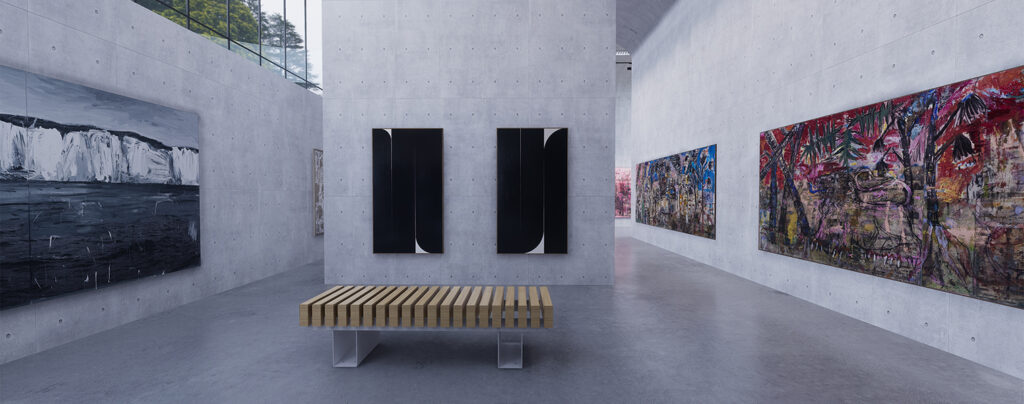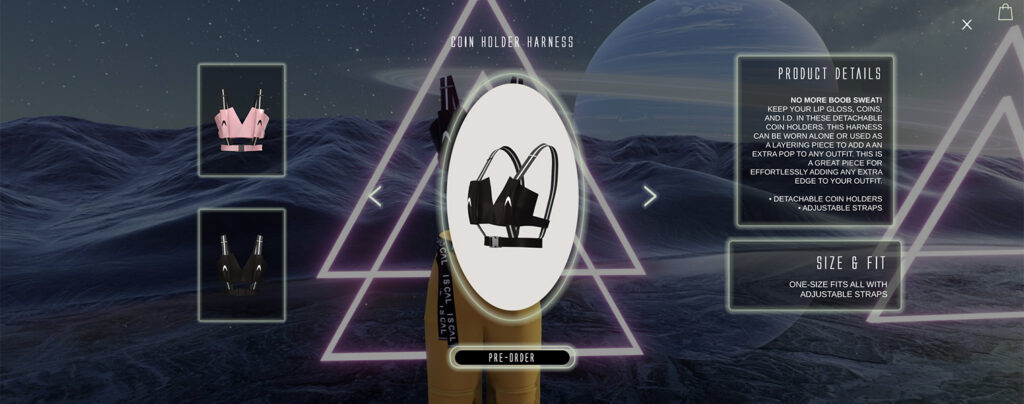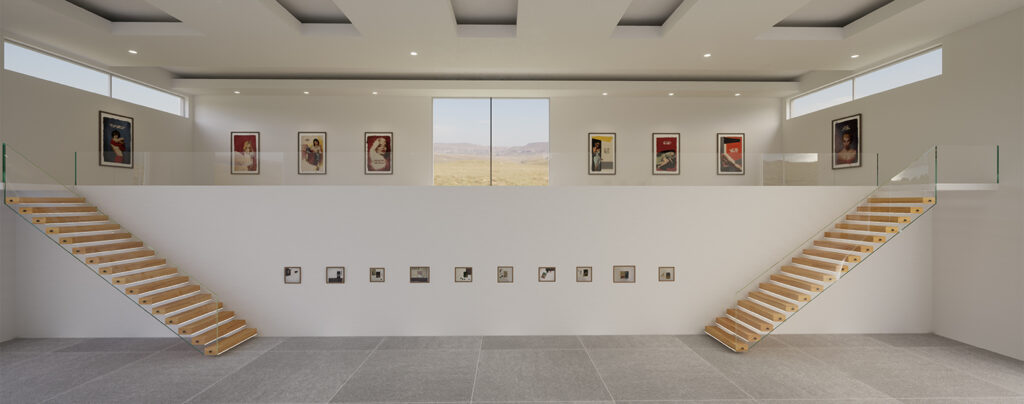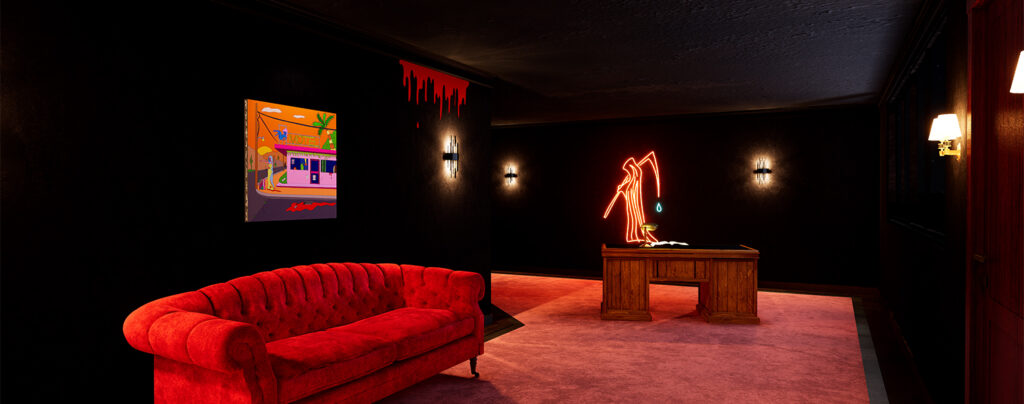We use cookies to improve your experience. By continuing to use this website you agree to our cookie policy.
A combination of the digital age, a global pandemic and an increasing interest in a low-impact lifestyle has meant companies are now having to be more reactive than ever before. The technology industry in particular has adopted a new, holistic approach to how we experience art and fashion. This year we used our in-house virtual reality software to house artworks from 22 different galleries, from London’s Alison Jacques Gallery, to Long Sharp Gallery in New York.
Our Founder & CEO Olga Dogadkina talks about the story behind Emperia, immersive virtual experiences, and answers commonly asked questions about the processes, features and costs involved when creating your virtual show.
How did you get into VR?
O: “I really noticed a problem with brands not being able to portray their brand identity through e-commerce.
There was this gap that I saw online, because luxury brands’ and high street stores’ e-commerce websites look very similar — and that’s kind of the big problem for brands in e-commerce and particularly luxury products. The environment in which they’re presented is really important because it’s part of the whole brand story and the reason people buy from them.
I was working with Microsoft on a project for fashion in 2017 when I tried VR for the first time. I thought: ‘If this was easy, if this was simple, this would be so incredible, we’d all just sit at home with a headset and shop the way we shop in reality but it would be even better because things can fly and physics don’t exist. If you want to display dresses in a field of flowers or shoes on another planet in another galaxy, you can do those things.’
That’s when I started looking at how VR could be applied to creative industries. I met my co-founder whose background is in games development and VR/AR and architectural visualisation. We married the two and started creating individual virtual experiences. We’d go to a gallery or go to a store and bring the headset and set it up for an event and create a unique experience that would be available in store.
But then we got a lot of demand for things that would run online and not just with a headset. Headsets are popular but not as popular as the Internet which you can access from anywhere, from any device. So we started doing a bit of both. But the majority of the stuff we do is web-based VR. So it’s essentially an immersive experience that allows you to interact with the products and feel like you’re part of the brand’s world.”
How do you create the virtual experience?
With 3D technology, your virtual space can be an exact replica of your physical store or gallery, or something completely different that only exists digitally.
O: “We have a library of 30,000 different textures (including about 15,000 different concrete floors) so any design can be achieved, no matter how experimental.
One gallery I was talking to recently wanted to put a really big painting in their virtual gallery which is an exact replica of the one in their physical space. They asked if we could shrink the painting to make it fit. I said: ‘well, you could shrink the painting… or we could make the ceiling higher!’ We can make those little adjustments and design the space you’re dreaming of having, rather than trying to just stick to what you’ve got in reality.

After the initial design step, we add the artworks or the clothing, which are all modelled and framed with 3D technology. All we need is high-resolution images of the works, then galleries can advise on the layout or how they’re supposed to be framed.
We create the frames in 3D, place them into the virtual space and create custom lighting for each piece — that’s what makes them look as realistic as they possibly can on screen. We have a feature that allows you to zoom into full-resolution of the artworks so you can zoom into every brushstroke (up to 500%).
We then add an overlay of information over that so every painting becomes clickable and you can really interact with every piece and see it in augmented reality, i.e. on your wall in your apartment.
With digital clothing, it’s a similar process but we work with patterns, so it’s stitched in 3D software and we can work essentially from a sketch — the item doesn’t need to physically exist. We can start from a rough drawing and reconstruct a whole collection in 3D.
With artwork, transactions are often made through enquiry because of the higher price point. But with fashion, things can be integrated with the eCommerce of the brand so you can purchase items directly within the same experience without having to switch and get lost in different tabs.”
How can I personalise my virtual experience?

Every element is customisable: from the space, to the artwork, to what frames go on the artwork. Even the pop-up windows for each painting or piece of clothing.
O: “We usually work within your brand guidelines, your logos and your fonts, making it completely authentic.
We can add any video and any audio. People love it when, with each artwork, you get to hear the artist talking about their painting. So you almost get a guided tour of the gallery. People feel more connected to the artist; it’s all about building this connection with something that they can’t reach otherwise.”
What are the most important factors when designing a virtual showroom?

Caption: Details like levels and lighting are what really tie a space together.
When creating a new virtual space, not emulating something that physically exists, key features to consider are high ceilings, floods of natural light (choose from floor to ceiling windows, high windows or skylights) and a mezzanine floor where you can go up and look down at all the artworks or garments beneath you.
O: “Those are usually the three elements that we try to factor into every space. But we’ve also seen that people respond really well to things that are different. So for Halloween, we’ve just worked on an experience for a London-based artist called Graceland with Maddox Gallery and created a virtual horror motel.
You feel like you’re there and you get to discover what’s happening in the hotel. There’s creepy audio, like creaking doors. It’s not the standard white walls and concrete floors that a lot of people go for, but we’ve had the best results from that experience, with people spending on average around 20 minutes in the gallery.”

Why should brands and galleries be investing in Virtual Reality?
Showcasing your product
O: “One reason is to showcase the detail of your product — because particularly with artwork, no one can really picture how big it’s going to look in their space or on their wall, but once you see it in relation to other things it can give you a much better idea of what the piece actually is and how it looks when it’s framed.”
Customer engagement
O: “We’re so overloaded with content these days, that people aren’t always going to want to watch a video for 20 minutes, but they might go and explore a virtual exhibition for that same amount of time. Those 20 minutes can be crucial and even if they don’t make a purchase straight away, it’s already a big stepping stone towards them becoming an actual customer.”
Accessibility
O: “Another thing, from a gallery perspective, is getting access to new audiences. For example, there is only a limited number of people who can physically reach a new show in Mayfair; not forgetting international customers or customers who can’t visit for whatever reason.
You might also want to reach other collectors in other countries who wouldn’t have seen your gallery otherwise. With art, it can be difficult to buy without seeing it or only seeing it on a two-dimensional page, but if you’ve already engaged with it, chances are you’re more likely to buy it.”
Sustainability
O: “From a fashion perspective, there’s the increased return rates and just better visualisation of the product. But we also address the sustainability factor a lot.
With a couple brands we’re working with now, we’ll make their collections in 3D and they will start selling it five months before it’s actually produced. So they can pre-sell it and get the exact order quantities and only produce what they sold and avoid wasting time, money and resources.”
How much does creating a virtual reality experience cost?
O: “We have two components in the price that make the total cost. The first one is that of the virtual space and that’s a one-off; once you get it you can use it continuously. They usually start from about £1,750 and go up to around £6,000, depending on the detail of the space.
For virtual shows, it starts from £1,000 for 20 paintings, to about £2,500 for 50 paintings (the more paintings, the higher the cost). But we don’t usually recommend anything more than 60-70. That’s to display them and includes everything from 3D modelling, to putting them in the space, to lighting and linking everything together. So the client doesn’t need to worry about anything.”
Is VR right for my business?
O: “In terms of what kind of businesses VR is right for, I would say anything from the premium end because you want to make it justifiable, so that when you sell things through it you get your ROI fairly quickly. So [invest] if you really want to make your brand stand out from the competition and see long-term results.
We’ve worked with a range of clients, including some art startups who have done the virtual experience with us. So it just depends on the price point of the products you’re planning to display. We think it makes more sense to make it continuous rather than a one-off experience, in order to see the investment really pay off. Plus, it keeps your customers engaged.”
What does the future look like for fashion, in a post-pandemic world?

O: “I think now, brands are starting to realise that this is the future and something that can be integrated into every step: design, production, sales, wholesale, so essentially every part of the cycle.
People, especially younger consumers, are so conscious about the whole environmental aspect of clothing that the brands that are at the forefront are actually winning with all the other aspects as well because people are keener on seeing that the brand makes the effort, rather than buying really fast and throwing away the next day because you wanted one Instagram picture in it.
The shift might be slow, however, what we’re seeing now is even when stores did reopen this year the footfall was really low. And that’s why brands have to adapt with the eCommerce shift and digital fashion experiences.
Pre-pandemic, everyone thought [the shift towards digital fashion] was something that might happen ten years down the line. Stores won’t die out but we probably won’t have quite as many of them because they’re just not needed and expensive to maintain. But the pandemic really accelerated this and brought those ten years down to right now.”
